Money Where Your Mouth Is: January 2012
Fair warning: if you didn’t know I was a moderately obsessive, detail-oriented, and rather analytical, you certainly will be the end of this post.
I love cooking and baking. Taking photos of the process, digging through shots to find the best ones to tell a recipe’s story, and sharing them with you. I get a thrill from planting seeds that, after a few weeks of sunshine and water, will produce food. And my weekly trip to the farmers market is a cornerstone of every weekend.
But part of my intent in starting this blog was to challenge myself toward a lofty goal. I’ve spent the last couple of years trying to buy locally (or grow myself) as much as I could, but I’d never really tracked how I spent my food dollars exactly.
The new year gave me a great opportunity to step. it. up.
I wanted to see just how much of my money I spent in a local food versus, well, non-local food. Easy enough, right?
Eh. It turns out it’s not quite so simple.
As I actually began smoothing out the wad of receipts in my wallet to enter totals on my fancy-pants spreadsheet, new questions developed: is there a consequential difference between buying groceries at a regional corporate chain and a national corporate chain? Is it important to distinguish between a locally-owned franchise offering a corporate product and a regular old chain restaurant? How do I value the food I grow myself? Should I track the food as I eat it, or as I buy it? Should I focus on only the food’s source, or the economic impacts of the food seller on my community?
After much deliberation, I think I found something that works. Is this the system you’d use? Maybe not. But for now, for me, this breakdown is specific enough to identify areas of improvement, but general enough that each pie graph isn’t seventeen colors.
Grocery Dollars
Spent on foods that are coming home to my pantry, fridge, or freezer
Self-Grown: Food from my garden plots and container garden, grown by me! I estimate the prices based on what I would pay at the farmers market for the same product.
Direct from Producer: Food purchased primarily at the farmers market, pick-your-own farms, or local food artisans. The more of my food I can swap for cash directly with the person who made that food, the better.
Co-op/Local Independent: I’m fortunate to have access to a grocery store co-op; the store is collaboratively-owned by members of the community, and any surplus profits are divided amongst the many co-owners each year. This co-op places a major emphasis on selling products that are locally, sustainably, or organically produced.
Large-Scale Corporate: Big box grocery chains. All of ’em. We debated the merits of regional chains compared to national chains, sustainable-focused versus conventional, but since my goal is to minimize my shopping at all of them, I lumped them all together.
So how’d I do?
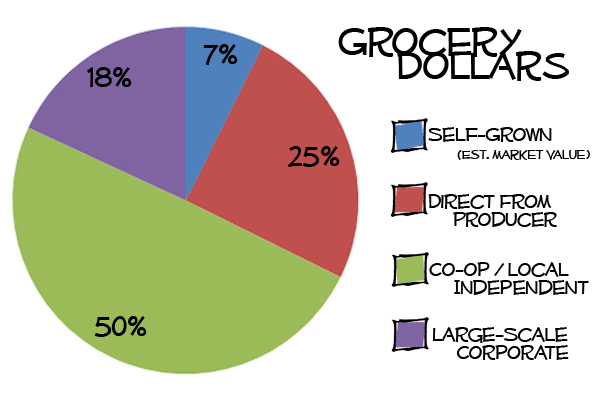 Not too shabby! For my first month of tracking, I spent only 18% of my money at large-scale, corporate grocery stores. With one of these grocery stores (a 24-hour one at that) less than a mile from my apartment, it’s very tempting to just run over there when I need something, ya know, RIGHT NOW. As the seasons change and more produce becomes available, I hope to reduce that purple slice even more.
Not too shabby! For my first month of tracking, I spent only 18% of my money at large-scale, corporate grocery stores. With one of these grocery stores (a 24-hour one at that) less than a mile from my apartment, it’s very tempting to just run over there when I need something, ya know, RIGHT NOW. As the seasons change and more produce becomes available, I hope to reduce that purple slice even more.
Restaurant Dollars
Food I buy at restaurants, coffee shops, campus eateries and the like.
Sources Local Food: Restaurants with a strong emphasis on sourcing local ingredients and omitting menu items that are extremely out of season.
One-of-a-Kind Independent: Those hole-in-the-wall local gems unique to your town. These restaurants don’t necessarily source local ingredients, but they provide plenty of local flavor and support restauranteurs willing to take a risk on opening their own place.
Local Owned, Corporate Product: A sort of catch-all category for those eateries that aren’t really independent but do still seem different from corporate chains. Franchises owned by a local businessperson. The little convenience store in the student center (a danger zone – lollipops shouldn’t be available this close to my office).
Large-Scale Corporate: The big national chains. The same menu in Vermont and California, in January and June.
How’d I do on this one?
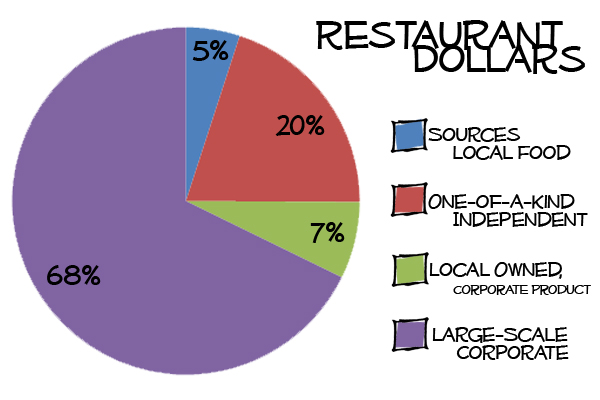 Ruh-roh. Though I knew this was coming, I’m still stunned by how big that purple pie is. Here’s the thing. Most of the really local restaurants are, let’s face it, EXPENSIVE. Or fancy. Or sit-down-y. Usually, all three. When we eat out, we are rarely looking for any of those attributes. On a brighter note, we have a gaggle of one-of-a-kind, independent restaurants here in Durham, and we are getting better at choosing those places for our meals out than the chains we became accustomed to in college. It’s a work in progress.
Ruh-roh. Though I knew this was coming, I’m still stunned by how big that purple pie is. Here’s the thing. Most of the really local restaurants are, let’s face it, EXPENSIVE. Or fancy. Or sit-down-y. Usually, all three. When we eat out, we are rarely looking for any of those attributes. On a brighter note, we have a gaggle of one-of-a-kind, independent restaurants here in Durham, and we are getting better at choosing those places for our meals out than the chains we became accustomed to in college. It’s a work in progress.
What does this mean?
It means it’s a start! Every month, I’ll make a new set of graphs and try to figure out how to improve. Ideally, the blue and red pieces of pie will grow, gradually pushing out the purple. Now I’m no fool: I know there will be challenges. Sometimes, the only place to eat in an airport is a chain. Also I don’t see myself forsaking burrito bowls at Chipotle. Or driving 20 minutes to the co-op instead of Harris Teeter when I’m halfway through cooking a meal and realizing I’m out of some key ingredient.
But the simple act of tracking has already made me think twice about how I spend my food dollars. Do I need to buy cheese today, or can it wait until a farmers market run on Saturday? What can I learn to make myself out of ingredients from local growers that can replace something I currently pull off the shelf at the store?
For what it’s worth: I think our individual choices matter. Just as each vote contributes to an election, every dollar spent on local food contributes to an economy that supports a vibrant network of farms, farmers markets, co-ops, and new local restaurants. As more and more people have taken an interest in where their food comes from, new farmers markets are popping up all over the place, local sections are appearing at even the largest of grocery stores, and more restaurants are proudly stating where their food was grown. It’s truly exciting.
Stay tuned! We’ll see how February goes, and I’ll be back with more graphs in a month.
What is important to you when deciding which food to buy?

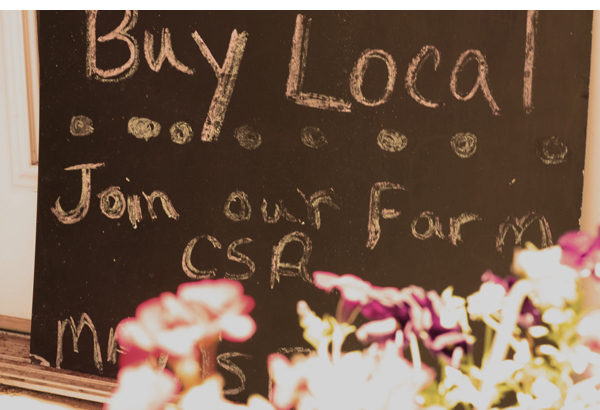
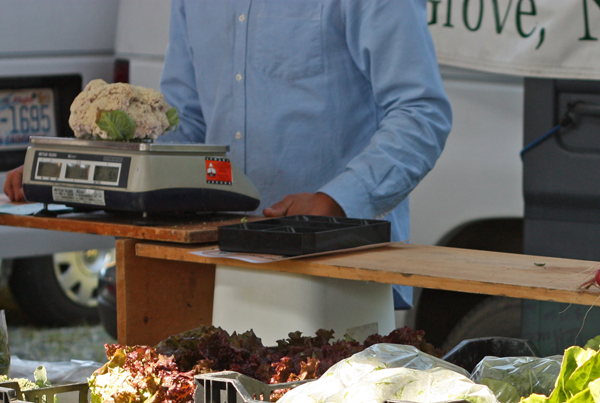
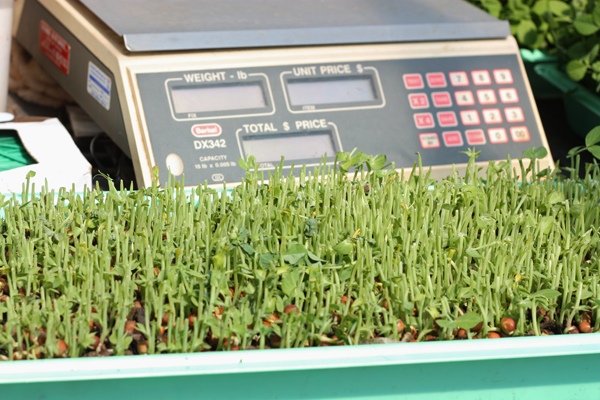
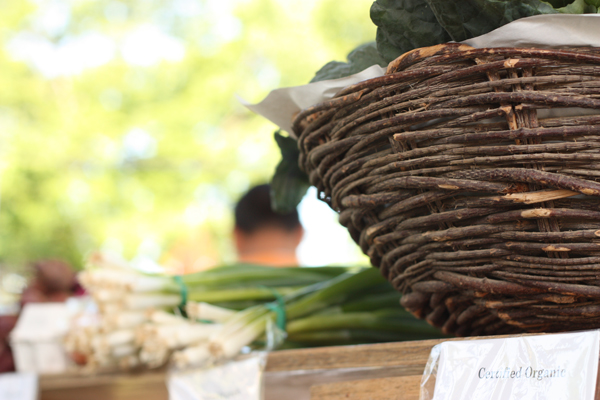

Paul Overton
February 8, 2012 @ 11:35 am
Thanks, Kristi! This is really inspiring and I’m sure it took no small amount of effort on your part.
Kristi @ 30 Pounds of Apples
February 8, 2012 @ 12:19 pm
Thanks! I can send you the spreadsheet template if you’re interested in tracking your own!
Rebecca
February 8, 2012 @ 12:29 pm
Inspiring, thanks! Please send your spreadsheet to me! Thanks!
Kristi @ 30 Pounds of Apples
February 8, 2012 @ 12:41 pm
Will do! Maybe I’ll see if I can figure out how to post it here for download…
Therese
February 8, 2012 @ 12:43 pm
I wish we had a co-op nearby. In my teen years I worked at a member co-op and learned how to do so many different tasks. Cutting up huge blocks of cheese, ordering food, stocking the produce, using a large old fashioned cash register…The motto back then was “Food for people, not for profit”
I have strayed from my weekly trips to the Farmer’s Market as I now have a weekly CSA box, and I find that pretty much takes care of all our produce needs. I am now rethinking this, as I spend $ each week at Trader Joe’s getting the produce I need to go with my CSA food. I am lucky to have two FM’s to choose from. Time to start visiting them again.
Thanks for such an insightful post. While I probably won’t be tracking my purchases, I will be keeping this information in mind when I do shop for food.
Oh, and it has given me another nudge to start planning this years garden!
Kristi @ 30 Pounds of Apples
February 8, 2012 @ 1:03 pm
I do very much love the co-op. I feel lucky to live close to a good one… I like the motto of the one where you worked!
It’s amazing to me how much food I can buy at the farmers market. Pickles and raisins and breads and pastries and dried herbs and seedlings and crafts… so much more than just produce and meat! I hope you enjoy returning to your local markets. :)
Lauren
February 8, 2012 @ 1:37 pm
I love your categories, particularly the way you separated out grocery dollars from restaurant dollars. Great food for thought applying them to my own food spending choices.